#social media marketing 2018
Explore tagged Tumblr posts
Text
youtube
Social Media Marketing: Boost Your Sales with Avs Digi Zone
In today’s digital world, social media marketing isn’t just an option; it’s a necessity. With billions of active users across platforms like Facebook, Instagram, TikTok, Twitter, YouTube, and email marketing, harnessing the power of social media is key to scaling any business. At Avs Digi Zone, we specialize in taking your social marketing strategy to the next level, boosting your brand visibility, engagement, and, ultimately, your revenue.
Ready to see how each platform can work wonders for your brand? Let’s dive into these powerhouse channels and how Avs Digi Zone can transform your approach.
#avs online stores#social media marketing#social media marketing 2024#social media marketing for beginners#social media marketing strategy#social media marketing tips#social media marketing agency#social media strategy#how to start a social media marketing agency#digital marketing#marketing#social media marketing course#social media manager#social media marketing tutorial#social media management#social media marketing 2018#social media marketing 2023#Youtube
0 notes
Text
2018 Key to Small Business Social Media Marketing
In the fast-paced digital landscape of 2018, small businesses were seeking the ultimate solution to harness the power of social media for their marketing endeavors. "2018 Key to Small Business Social Media Marketing" was a comprehensive guide that was a beacon of knowledge during this transformative year.

0 notes
Text
Importance of Digital Marketing Compared to Old-Time Newspaper Marketing
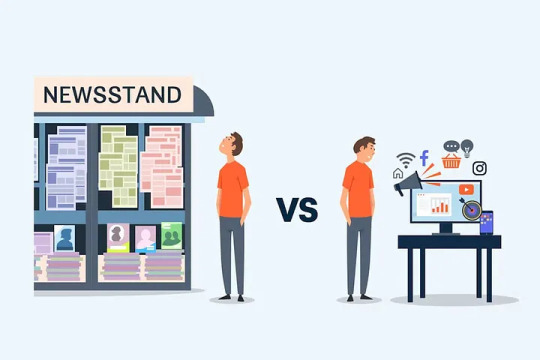
There is no denying that the Internet, coupled with technological advancements, has revolutionized the face of marketing. Earlier, the best and the most effective way to promote a business was to get display ads printed in newspapers. But times have changed. Today’s generation is more hooked to the digital world than printed media. Consequently, there is a growing need to shift focus on digital marketing. There is no exception for the healthcare industry as well.
What is Healthcare Digital Marketing?
In healthcare, digital marketing refers to using digital platforms such as social media and websites as tools for marketing communication. The “sponsored ads” that pop up on your social feed and the emails you get from healthcare companies are all a part of digital marketing.
Trends in Healthcare Digital Marketing in India
The past few years have been witness to India emerging as one of the fastest-growing digital economies globally. The period between 2014 and 2017 saw the digital adoption index growing by 90%. Regarding revenue, the Indian digital healthcare market stood at a valuation of $ 116.61 billion in 2018. The numbers will expectedly hit INR 485.43 billion by 2024, with a CAGR of around 27.41% during the years 2019–2024. (Source.)
Why Are the Downsides of Traditional Marketing?
The traditional marketing mode is a conventional method to reach out to a semi-targeted audience through various offline advertising methods. It usually comes in prints, broadcasts, direct mail, telephone, and outdoor advertising like billboards. However, conventional marketing has the following drawbacks:
Very costly
Almost no direct interaction with the audience
Making updates is not easy in a static newspaper ad or an already aired TV commercial.
No room for customizations to target a specific audience
Measuring ROI becomes tough.
The rate of leads converting into paying customers is meager.
Receiving feedback is not easy.
Why Go Digital with Healthcare Marketing?
As per ClickZ, the global population has 57% internet users with an average online activity of 6 hours 42 minutes each day. (Source) With different channels like social media, websites, content marketing, pay-per-click, and more, there can be no better time to tap the digital platform’s potential. While traditional newspaper marketing is still useful, technology makes it easier to broaden your outreach, especially when offering something essential, like healthcare services. So here are the top benefits of adopting digital marketing:
Better audience profiling
Direct interaction with the target audience.
Better prediction of customer behavior
Easier to get feedbacks on your service or brand
Tracking your marketing progress is easy.
Cost-effective compared to traditional advertising.
Enough scope for customizing and updating marketing communication
Conclusion
With progressive government policies, India’s robust digital footprint has played a vital role in nurturing the country’s digital healthcare ecosystem. Healthcare providers are turning to digital media to grow their business while offering their services to the public. Digital marketing has promising prospects for the future, far outweighing the limitations posed by traditional marketing.
There is no denying that the Internet, coupled with technological advancements, has revolutionized the face of marketing. Earlier, the best and the most effective way to promote a business was to get display ads printed in newspapers. But times have changed. Today’s generation is more hooked to the digital world than printed media. Consequently, there is a growing need to shift focus on digital marketing. There is no exception for the healthcare industry as well.
What is Healthcare Digital Marketing?
In healthcare, digital marketing refers to using digital platforms such as social media and websites as tools for marketing communication. The “sponsored ads” that pop up on your social feed and the emails you get from healthcare companies are all a part of digital marketing.
Trends in Healthcare Digital Marketing in India
The past few years have been witness to India emerging as one of the fastest-growing digital economies globally. The period between 2014 and 2017 saw the digital adoption index growing by 90%. Regarding revenue, the Indian digital healthcare market stood at a valuation of $ 116.61 billion in 2018. The numbers will expectedly hit INR 485.43 billion by 2024, with a CAGR of around 27.41% during the years 2019–2024. (Source.)
Why Are the Downsides of Traditional Marketing?
The traditional marketing mode is a conventional method to reach out to a semi-targeted audience through various offline advertising methods. It usually comes in prints, broadcasts, direct mail, telephone, and outdoor advertising like billboards. However, conventional marketing has the following drawbacks:
Very costly
Almost no direct interaction with the audience
Making updates is not easy in a static newspaper ad or an already aired TV commercial.
No room for customizations to target a specific audience
Measuring ROI becomes tough.
The rate of leads converting into paying customers is meager.
Receiving feedback is not easy.
Why Go Digital with Healthcare Marketing?
As per ClickZ, the global population has 57% internet users with an average online activity of 6 hours 42 minutes each day. (Source) With different channels like social media, websites, content marketing, pay-per-click, and more, there can be no better time to tap the digital platform’s potential. While traditional newspaper marketing is still useful, technology makes it easier to broaden your outreach, especially when offering something essential, like healthcare services. So here are the top benefits of adopting digital marketing:
Better audience profiling
Direct interaction with the target audience.
Better prediction of customer behavior
Easier to get feedbacks on your service or brand
Tracking your marketing progress is easy.
Cost-effective compared to traditional advertising.
Enough scope for customizing and updating marketing communication
Conclusion
With progressive government policies, India’s robust digital footprint has played a vital role in nurturing the country’s digital healthcare ecosystem. Healthcare providers are turning to digital media to grow their business while offering their services to the public. Healthcare Digital marketing has promising prospects for the future, far outweighing the limitations posed by traditional marketing.
Source: https://comhes.com/
#There is no denying that the Internet#coupled with technological advancements#has revolutionized the face of marketing. Earlier#the best and the most effective way to promote a business was to get display ads printed in newspapers. But times have changed. Today’s gen#there is a growing need to shift focus on digital marketing. There is no exception for the healthcare industry as well.#What is Healthcare Digital Marketing?#In healthcare#digital marketing refers to using digital platforms such as social media and websites as tools for marketing communication. The “sponsored#Trends in Healthcare Digital Marketing in India#The past few years have been witness to India emerging as one of the fastest-growing digital economies globally. The period between 2014 an#the Indian digital healthcare market stood at a valuation of $ 116.61 billion in 2018. The numbers will expectedly hit INR 485.43 billion b#with a CAGR of around 27.41% during the years 2019–2024. (Source.)#Why Are the Downsides of Traditional Marketing?#The traditional marketing mode is a conventional method to reach out to a semi-targeted audience through various offline advertising method#broadcasts#direct mail#telephone#and outdoor advertising like billboards. However#conventional marketing has the following drawbacks:#Very costly#Almost no direct interaction with the audience#Making updates is not easy in a static newspaper ad or an already aired TV commercial.#No room for customizations to target a specific audience#Measuring ROI becomes tough.#The rate of leads converting into paying customers is meager.#Receiving feedback is not easy.#Why Go Digital with Healthcare Marketing?#As per ClickZ#the global population has 57% internet users with an average online activity of 6 hours 42 minutes each day. (Source) With different channe#websites
0 notes
Text
I saw an early screening of the Mean Girls movie last night, so here is a summary of my thoughts, comparing the movie musical to the Broadway musical, which I was lucky enough to see live in 2018!
Changed that I liked:
The usage of social media in the Broadway show made it very clear that it was written by adults who didn’t know much about Gen-Z. It was probably one of the worst parts of the show in my opinion. But Tina Fey must have done her research since 2018, because the way the movie uses TikTok, memes, vlogging, and FaceTime to push the story forward worked VERY well. I think there were some influencer cameos, but it didn’t feel they were included to show how “young and hip” they were, It actually added authenticity.
The diversity within the cast and changing last names to reflect the characters’ backgrounds (Karen Smith ➡️ Karen Shetty, Janis Sarkisian ➡️ Janis 'Imi'ike)
Cutting down “Meet the Plastics.” It’s a very exposition-heavy song and doesn’t need to be super long, even though the full version is quite catchy and fun.
All of the new jokes landed so well, probably because Tina Fey’s writing style is better suited for the screen as opposed to the stage.
This is more of a comparison of the musical vs. the original film, but a big change was The Plastics’ weaponized wokeness (which I talk about here).
The production design for most of the songs was very different. The stage musical has a lot of rock songs, which were changed to a pop sound for the movie. I personally prefer rock musicals, but it was a good way to give the movie a separate identity from its predecessor so it doesn’t risk becoming a carbon copy. It worked on some songs (“Someone Gets Hurt” and “World Burn”) but not on others (“A Cautionary Tale” and “Revenge Party”).
Cutting the joke about Regina’s ass being big. It was a very low-brow joke, which I’m not a fan of, and was just really immature. Thank God that was changed to her falling, which still shows her being embarrassed without her body being the joke.
Explicitly making Janis a lesbian! (It’s only implied in the stage show with “It’s not even true… I only have one butt”) And she goes to prom with a girl while Damien dances with a boy! ALSO THERE’S REJANIS LORE AND IT’S SO HEARTBREAKING I LOVE IT
megan thee stallion just… being there
Miss Norbury and Principal Duvall being a couple and owning a dog together!!!
As a low mezzo, I appreciated whoever decided to lower the key for “I’d Rather Be Me.” I felt very represented 🩷
Having Cady be raised in a single-parent household so it focuses in more on her relationship with her mom. Jenna Fischer was so motherly and sincere and brought a warmth to the movie. Their scene together near the end made me emotional (you’re never too old to ask your parent to stay with you until you fall asleep) (also this is my request to make jenna fischer my mom)
Changes that I didn’t like:
Cutting BOTH of Damian’s solos??? (SHE’S LEAVING!!!!!!!! JUST LIKE MY DAD!!!!!!!!!!!!!!!)
Cutting “More Is Better.” It wasn’t necessarily a memorable song, but it did give both Cady and Aaron more depth, both as separate characters and within their relationship.
While cutting some of the songs helped with pacing, cutting HALF of the score made me forget that it was a musical sometimes, which sucks because I really like musicals!!!
Other stuff:
The movie was marketed horribly. One of my friends didn’t even know it was gonna be a musical because there were no songs in the trailers 💀 (Also, this isn’t just a Mean Girls problem. The Color Purple also didn’t have any songs in the trailer. I didn’t even know Wonka was a musical until I saw it in theaters, so that was a bit of a shock.) If you’re producing a musical movie, maybe your focus groups should be musical fans, because that’s still a HUGE market.
Auliʻi Cravalho’s voice is STUNNING! She and Jaquel Spivey had great chemistry and their friendship felt so genuine!
The opening and ending transitions from the garage were everything to me
The EDITING
Angourie Rice is a great actor and fit Cady perfectly… except for her singing. Out of the entire cast she was easily the weakest in terms of vocals and it was pretty disappointing since she’s the LEAD. I could barely hear her in the new song “What Ifs” because of how quiet and breathy she was. I think it’s a better written song compared to “Roar” though.
Jon Hamm cameo!
Ashley Park cameo!
I cannot stress enough how funny this movie was. I was probably laughing louder than everyone else in the theatre.
I lost my shit during “Meet the Plastics” when Regina unzipped her jacket and Cady was staring at her boobs. She’s just like me fr 🏳️🌈
I know that Regina is a horrible person but I couldn’t find it in me to dislike her in the slightest. She just served too much cunt 😩
Christopher Briney is a good actor, but I don't think he was the right choice for Aaron Samuels. I would hate to ridicule anyone for their looks, but it still plays an important part in casting. Aaron is supposed to be a somewhat naive, wholesome, hot jock (and Regina has high standards, so he better be a fucking model). Briney is definitely a cutie, but gives off “smoldering badboy with a secret sensitive side” energy, which isn’t what Aaron should be.
The fantasy sequences (Stupid With Love, Revenge Party, October 3rd). I LOVE when movie musicals USE the medium to tell stories in a way that they can’t on a stage!!!
THE CHOREO!!! Everyone freezing then shaking in “Someone Get Hurt” AHHHH that entire number was HYPNOTIZING!!!!!!!!!!! My friend told me the choreographer’s name is Kyle Hanagami, so shout out to him. (also reneé rapp was so fucking hot while singing that oh my lord)
I will be calling my pimples “face breasts” from now on (avantika ilysm)
DAMIAN’S FRENCH COVER OF THE ICARLY THEME SONG 🙏🙏🙏🙏🙏
why was there a 0.5 camera shot of cady during revenge party 💀
“I’d Rather Be Me” was so much fun and I felt so fucking empowered. And the transition from the song to the bus was just *chef’s kiss*
“donut worry i am still your freend” 🥺
Lindsay Lohan cameo!!!!!!!!!
NOT ENOUGH RENEÉ RAPP 😭😭
Overall, the movie was not perfect, but the Broadway show already had plenty of flaws, so it’s understandably how that would affect the adaptation. I still a LOT of fun and would definitely see it again. Go stream Snow Angel by Reneé Rapp. i love women 🥰🥰🥰
#summer says stuff#mean girls#mean girls 2024#mean girls musical#mean girls broadway#tina fey#karen shetty#janis 'imi'ike#regina george#rejanis#megan thee stallion#cady heron#jenna fischer#damien hubbard#aaron samuel’s#Auliʻi Cravalho#jaquel spivey#angourie rice#cadgina#christopher briney#reneé rapp#avantika
661 notes
·
View notes
Text
Y'all are going to like this one.
SWIFTIES DON'T TOUCH THIS POST WITH A TEN FOOT POLE, I SWEAR TO FUCKING HELL-
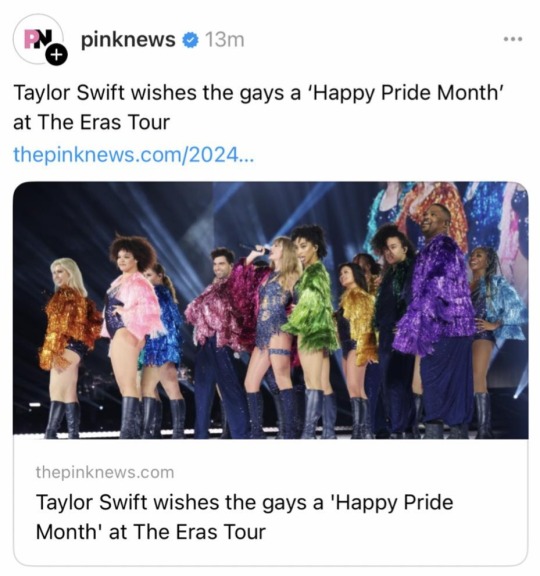
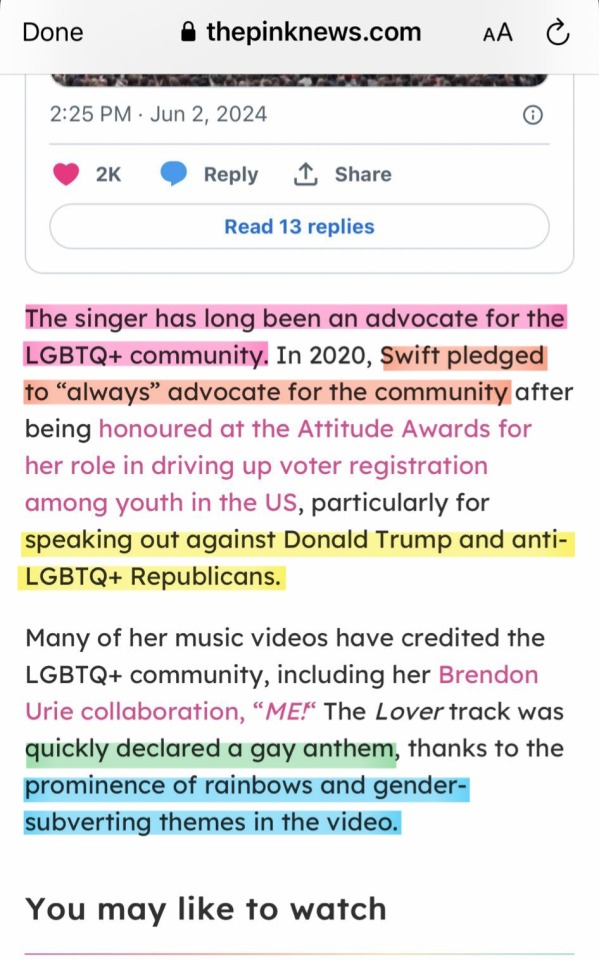
So my friend sent me this article, and I'm going to tell you why I think it's complete bullshit.
1) wishing us a happy Pride month is the BARE MINIMUM. As someone with her presence in the media and social influence, she could - and should - be doing SO much more than just wishing us a happy pride four days in.
2) "the singer has been an advocate for the LGBTQ+ community" not a good one. She seems to only remember us when it's convenient or benefits her in some way. Case in point:
2018 - "When it comes to feelings and when it comes to love and searching for someone to spend your whole life with. It's all just really really delicate. You know?" Taylor then performed her song "Delicate."
2023 - It’s painful for everyone, every ally, every loved one, every person in these communities.
In the first example, the intentional song reference comes off as extremely tacky. This is people's LIVES you're talking about. People are MURDERED for who they are and who they love (or don't love). This isn't an appropriate time to pull out the "oh-so-quirky" act and be cutesy.
In the second, the fact that she can't even center queer people in their own experience is so, SO telling. I promise, however painful it is for allies, it's 1000x worse for us to LIVE it. Allies don't have to wonder "am I going to get hate crimed wearing this?" before they leave the house - we frequently do. To not acknowledge that shows me that everything she says is performative at best.
3) I wouldn't call what she does "advocacy". She mentions us every now and then when it's convenient for her, profits off of us when we fit her marketing plan, and I've yet to find where she actually apologized for the homophobia in the original version of Picture to Burn. Also, she's real good friends with Travis Kelce's dad, who is a raging transphobe (and I bet his kids are, too). You don't get to call yourself an ally if you willingly allow the people around you to be violent bigots.
4) "always" is a strong word for someone who seems to show her support situationally at best. The full quote was "The way for that to happen is for us to continue to keep pushing governments to put protections in place for members of the LGBTQ community. And I promise to always advocate for that." Yet she doesn't do that.
5) what she speaks out, I've noticed that it's nearly always in the states that primarily agree with her. We don't see a whole lot of her "inspiring ally" speeches in places like Texas or Florida. But I've seen plenty of them come out of already notoriously queer-friendly places. If you aren't willing to face the heat of the difficult places along with the comfort of the easy ones, you don't get to call yourself an ally. Allyship is not easy. Anyone remember when Lady Gaga advocated for us in Russia, under threat of arrest, and her response was "arrest me, Russia! I don't give a fuck!"? Yeah, I've never seen even half that level of true commitment from Taylor.
6) STOP. MAKING. STRAIGHT GIRL SONGS. "GAY ANTHEMS"!!!! FFS it's such a slap in the fucking face of REAL, ACTUALLY QUEER ARTISTS that y'all keep calling these piss pathetic straight girl over produced crap songs "anthems". Fucking stop it. If they aren't queer, they don't qualify to be a queer anthem or icon. Start supporting ACTUAL queer artists with ⅛ this energy, for the love of FUCK. This bullshit pisses me off. Do you need a list of queer artists? I'll make you one by hand if you promise to stop trying to label Raylor Swift's straight girl shit songs as "gay anthems".
7) rainbows and gender subversion are not exclusively nor inherently queer. If that's our bar for "gay anthems", the bar is so low Lucifer himself needs a damn Webb Telescope to just barely see it from hell.
#anti taylor swift#taylor swift critical#anti swifties#swifties dni#SWIFTIES I SWEAR DO NOT TOUCH MY DAMN POST
273 notes
·
View notes
Text


'Vallecitos' is a luxury earthship house built in 2018 in Taos, NM. It's been featured on Netflix, international TV and social media, among the pages of Forbes and AirBnB magazine, and many others, yet it's been on the market for almost 2 yrs. 2bds, 2ba, asking $825K + $20mo. HOA fee. Let's take a look inside.


So, the typically long earthship garden that is usually inside the house, is separate here, and like a greenhouse decorated with bottles in the pretty turquoise walls.

Food grows out here- I see lettuce, aloe vera.

And, look at this- bananas. Or are they plantains?

I must say that the living room is nice, but the dining area is a little tight.

We've seen some pretty primitive earthships before, but this actually looks like a home with beamed ceilings and quality glass doors and windows.

A real kitchen and it's very pretty. Love the turquoise cabinets.

It even has a pantry and laundry room.

Very nice bath and what looks like a real flushing toilet, not a composter.

Beautiful tile sink.


The secondary bedroom is lovely. It looks like a child's room and has plenty storage for toys, games and books. A desk faces the garden window.

As we can see, the garden runs the whole length of the large "ship."

The primary bedroom is nice.

It opens to the garden area.


Pretty en-suite. I would need something on that window, though.


Out on the patio they have a sauna.

Patio looking out over the 2.31 acre lot.

View of the back of th house with the sauna and patio.


Partial privacy wall around a deck.

Aerial view of the property shows grass and vegetation, but it's quite vast and empty.

Glamor shot of it at night.
https://www.zillow.com/homedetails/27-Earthship-Way-Taos-NM-87577/2061804094_zpid/?
195 notes
·
View notes
Text
women in motorsport: a semi-curated mini academic reading list (with links!)
These articles broadly cover the position of women within motorsport and interrogate the misogyny of that ecosystem. I found quite a few more, some of which go in depth about the hypermasculine norms responsible for the exclusion of women from that space. If you want those titles, let me know, but otherwise I think these comprise a solid foundation to academic thought on the subject.
John M. Sloop, "Riding in Cars Between Men," Communication and Critical/Cultural Studies 2, no. 3 (September 2005).
Discusses several incidents in the racing career of Deborah Renshaw, including an 2002 incident in which a unified group of her competitors, all male, successfully conspired to disqualify her car from competing. Makes some really interesting points about "first women" in male-dominated environments and the simultaneous erasure/amplification of gender difference when discussing women in motorsports.
Elizabeth Lick, Rashid Bakirov, and Tauheed Ahmad Ramjaun, "Female motorsport fan engagement on social media-based brand communities," Journal of Digital & Social Media Marketing 12, no. 1 (2024)
Written for an audience of social media professionals within F1 looking to expand their reach to female fans - but an enlightening read for anyone involved with online motorsports fandom. Concludes in part that women are less likely to actively engage with official F1 social media (leaving comments and the like) because of how men react to women in those spaces, and proposes a few adjustments teams could make to make women more likely to interact with posts.
Ehren Helmut Pflugfelder, "Something Less than a Driver: Toward an Understanding of Gendered Bodies in Motorsport," Journal of Sport and Social Issues 33, no. 4 (2009).
A big jargony, but worthwhile if you can parse the language - goes into depth about the woman driver as a "cyborg identity" (in the vein of Donna Haraway's Cyborg Manifesto): something both mechanical and human, and thus embodying more complex gender dynamics.
Honorata Jakubowska, "The Awkward Gender Politics of Formula 1 as a Promotional Space: The Issue of 'Grid Girls,'" in The History and Politics of Motor Racing (2023)
Revolves around the decision to drop the longtime tradition of "grid girls" at races in 2018, though reflects generally about the role of women in the homosocial world of F1. Argues that the symbol of the sexualized grid girl--present to celebrate race winners and bolster marketing efforts--contributed to the spectacle of F1 and underscored its claim as the most glamorous, luxurious, and elite form of motorsport.
122 notes
·
View notes
Note
Hello there!
I’m new to f1 and Lestappen.
Is there a Charles and Max master post somewhere with their history? I keep hearing about the social media unfollowing and podium walk off and want all the tea and timelines.
Basically all I know about is the inchident.
Many thanks!
hello and welcome!! my scholarship (read: obsessively reblogging things or bookmarking them thinking i'll actually find them again later) tends to be VERY chaotic, but i know there are definitely compilations out there. i've read some great ones.
nini (@scuderiafemboy) has a LOT of lore content on tumblr and twitter & does a lot of translating of dutch interviews/manages to unearth old interviews all the time. the twitter thread of threads covers 2018 through june 2023! she also compiled some of the database on tumblr here.
@chibrary archives interviews, articles, etc., in glorious fashion. this is charles centric but naturally charles' history intersects with max's so there are some good pieces in there, like this 2015 article on the lestappen rivalry in karting. the #driver:max tag provides a lot of golden content (such as extended lore on the inchident!).
moments™
marginally related, but dani (lecstappens on twitter) once posted the video of max and charles being scolded and warned to behave themselves during the race following the inchident. one of my favorite pieces of lestappen info frankly... demon children. (also on posted by @il-predestinato on tumblr here. who, btw, is a gold mine of lestappen content.)
well, as long as i'm adding some favorite gems while i try to find the specific post i'm looking for... the lestappen singapore flag moment is my roman empire. i am also haunted by the awkward weather convo video. which i know is out there, but i am going crazy trying to find it.
i decided to just commit to the moments list, so here is charles drinking red bull gate 2023 (courtesy of @countingstars-17)
charles asking the tifosi to stop booing max at monza this year (@il-predestinato seriously has so much content)
this excerpt of max's manager talking about charles (@blueballsracing)
if i don't stop myself i will be here all year
more mini compilations !!
@hyacinthsdiamonds once produced a nice list of the ridiculous lore around lestappen that sounds made up
some 2021 specific "best moments" compiled by @coconutshygame
there is one post i am thinking of that touched on their wild lore/destined f1 rivalry etc. but i can't find it now so stay tuned 🫡
also, for some theorizing on the most recent lestappen debacles and what it all means with ferrari/rbr and a potential charles to rbr (ot charles to more power at ferrari) move:
@tsarinablogs is a Scholar™ with lovely essays
@valyrfia has an addition to the marketing mayhem
i recently compiled my unhinged #rbr-ferrari sticker war content to advocate for rbr charles here, which was added to by this anon with banger points
personally i use #rbr charles for the theorizing and delulu hours, but i think #lestappen rbr and #lestappen gate 2023 are also prime hunting ground for rbr specific lore
anyone who has info to share pls do ❤️ i know i'm missing loads of scholarship that is lost in the pits of my unorganized blog
#what i have learned lately is i should be tagging my specifically again afnkafas#me never finding anything else#getting distracted by lestappen but not the lestappen i need#typical#*oracles#rbr charles#lestappen#oh now is a good time#lestappen lore#ah ha#new tag!#f1#charles leclerc#max verstappen#tag purists dont @ me this isnt really shippy
318 notes
·
View notes
Note
I don't know if you have enough data to answer this, but I believe that the Sussexes are becoming more irrelevant, people have just lost interest: do you get the same number of rumors nowadays as you did a couple of years ago? Or less?
What's your "sentiment" about this, if you feel inclined towards a little speculation?
I don’t have any quantitative data, this is just based on my observations.
First, the media’s interest in the Sussexes has dropped significantly. It used to be that they had new stories on them daily. Every day, no matter the occasion or what else was happening. Now, it’s about once a week, if that. (Excluding when they’re on “foreign tours”.)
Second, they’re not organic discussions on social media. They aren’t in the algorithms unless there’s a huge PR push (aka $$$) involved, like with the recent ARO product “launches” or the rumormongering about Kate’s health/the Waleses’ marriage. That means people aren’t talking about them until they’re paid to talk about them and then they go to work with trending topics and algorithm manipulations.
Third, there was a huge reckoning during the pandemic that saw an enormous shift away from the celebrity influencer culture of the ‘10s. People aren’t paying attention to celebrities just because they’re pretty or famous or wealthy anymore. People are paying attention to, and supporting, people who have values, who do something, who are meaningful.
That’s not the Sussexes. The Sussexes - Meghan more so than Harry (because Harry still offers purpose through Invictus Games, but he destroyed a lot of it with the whining in Spare) - are trapped in their “famous for being famous” mindset that was the late ‘90s - mid ‘10s. They haven’t evolved as the culture and as society has evolved. Meghan tried, with all those bandwagon trends and topics she spouted 2018 - 2021, but they always failed because everyone could clearly see she didn’t actually care about those things, she was only using them. So people aren’t giving them attention because they don’t fit the current model for our idea celeb. (And that’s why you see a lot of celebs hustling with their own companies and brands or charities now, separate from their acting or music or modeling - the market has shifted from their pretty faces to the contributions they give to society at large.)
Fourth, the Sussexes greatly overestimated the Oprah interview and their “revenge era” against the BRF (the time from Oprah to Spare when they were, more or less, gossiping about the BRF and whining about not having enough privilege). Their expectation was that everyone would be on their side and we would all condemn the BRF with them. They overestimated and misunderstood that the global majority of the world a) respected The Queen as much as we did, b) saw it was completely ducked up to have done the Oprah interview while Philip was literally dying (and also the Sussexes’ claim that “they’re just saying he’s sick so we don’t do this interview” was all sorts of inappropriate), and c) would never air our own family’s dirty laundry in public like that and judged them horrendously for doing that to The Queen and the BRF while their patriarch was dying. That alienated a lot of people and the result wasn’t “all hail Harry and Meghan, Royal Freedom Fighters” (which was the Sussexes’ expectation); it was “who the f@&k do they think they are” (especially after Fleet Street published about all the lies they told during the interview with receipts).
And finally, the biggest indicator that they’ve become irrelevant is the blogs here. Just look at how many blogs have stopped posting or changed their content. There’s a huge group of bloggers that left or lost interest, and the blogs that remain tend to fall on either side of the spectrum: they either love the Sussexes or they hate them. There’s no middle ground anymore, and it kinda does actually suck. It doesn’t mean the neutral/middle blogs and anons and readers don’t exist (they do, they’re here, I see them on my dash and in my mentions) but they’re lurking more than engaging. The people engaging are people that either love or hate the Sussexes, so there’s a lot of “same” being blogged and discussed. (It’s why I’ve not been posting recently - I get bored when we talk about the same things over and over so I check out for a bit until I can think of something (or see something) different to change the conversation with or I get anons with questions (like this one) that scratch an itch in my brain.)
So to that question, yes, the Sussexes are becoming irrelevant. They’ve become quite irrelevant if you go by the media and social media that was happening in 2017 when they got engaged.
For your question about the rumors and theories, yes. There’s been a huge drop off in those as well. I used to be updating my spreadsheet daily with all the gossip and discussions happening, but now, it’s just once or twice a month. I will admit that part of that is because the sources I used have become venomously anti-Sussex or anti-Kate and I’m just not interested in that so I don’t go to those places as much anymore. But another part of it is that there’s just an absence of people talking about it. The people left discussing the Sussexes are, again, either you love ‘em or you hate ‘em and that brings a certain bias to the rumor mill and the conspiracy theories, which can actually become very toxic very easily because there’s no one left to moderate or play devil’s advocate to remind everyone that these are real people with real families and real lives; yes, running away with your imagination is fun but it’s also not a realistic barometer of who these people (the subjects of the gossip, the sources of the gossip, and the consumers of the gossip) are.
And I think when you’re left with the two extremes of the spectrum - haters and lovers - that’s the ultimate show of irrelevance. The “middle” (or the silent majority, if you will) has completely noped out of the conversation and doesn’t have even a rat’s ass to give you.
That’s why all the Sussexes have left is either divorce or reconciliation with Charles, William, and Kate. If either one of those things happen, they’ll suddenly become relevant again. But they don’t either of those. They can’t afford either of those options reputation-wise because both options end with egg on their faces and a global chorus of “I told you so” from family, press, and the public.
So they’ll just stay stuck getting more and more irrelevant because their egos are too enormous to allow being served some serious humble pie.
71 notes
·
View notes
Text
I’m pretty sure the people bitching about not giving money to tumblr are the same ones who complain when AO3 or wikipedia ask for donations, so I’m just gonna clarify something
Running a website is not free
Even if they made no changes and did only maintenance, they still need to pay for server costs, expert programmers for when something goes wrong, storage (although frankly storage is cheap as chips these days which is nice)
They need to keep up with the capabilities of new tech like improvements to web browsers, never mind their own apps keeping pace with old and new tech developments
Backwards compatibility (being able to run the updated app on old tech) is a massive problem for apps on a regular basis, because there are people out here using an iPod and refusing to update software
There’s a reason every few years apps like Animal Crossing will issue an update that breaks backwards compatibility and you can only play if your phone is running more recent software
This shit costs money even before you look into the costs of human moderation, which I’m not exactly convinced is a big part of their current budget but fucking should be if we want an actual fix for their issues with unscreened ads and reporting bigots
Ignoring that it’s apparently illegal for companies not to actively chase profits, running Tumblr is expensive
And advertisers know we fucking hate them here
They’re still running ads, which we know because they’re all over the damn place, but half the ads are for Tumblr and its store
Other ad companies know we are not a good market, so they’re not willing to put the money in
Tumblr runs at a $30 million deficit, every year, because hosting a site is expensive
They are trying to take money making ideas from other social medias because they’re not a charity; they need to make enough money to keep the site going
If you want tumblr to keep existing, never mind fixing its many issues that require human people to be paid to do jobs like moderation, they will need money
Crabs cost $3
One crab day a year can fix the deficit and hammer home for Tumblr that:
A) we do want to be here and want the site to keep going
And B) they do not need to do the normal social media money making strategies we all hate
They need a way to make money if you want the hellsite to exist, because we live in a capitalist hellscape and cannot all be AO3
If they think they can make enough to keep running without pulling all the tricks we hate, they have no reason to pull said tricks
But they need money
And a way to make money
And if we can show them we can do that, there is a significantly higher chance they will listen to us, the user base they need money from, than if we don’t
Tumblr isn’t perfect, or anywhere close. They need someone to actually screen the paid ads they put through, they need to take the transphobia, antisemitism, and bigotry seriously
These Are Jobs That Will Cost Money
People Need To Be Fucking Paid For Their Work
Tumblr Is Not Run By Volunteers For Free And Nor Should It Be
Paying People Is Good Actually
So if you wanna get all high and mighty over $3/year, by all means, go spend that hard earned cash elsewhere
Good luck finding a perfect and morally pure business to give it to though
Being a whiny negative asshole isn’t more appealing just because you’ve put yourself on a moral soapbox, it just means the asshole is a little higher up
For all the whining about “all the new updates are terrible this site is unusable”…. It’s one fuck of a lot more usable than it was in 2017, 2018, 2020
And yeah, it’s going back down and most of the newer ones have been fucking annoying and I would also like them to stop
But it got up somehow and that means it could do that again
Hope is more fun than edgy nihilism
August 1st is a good and exciting day to summon a crab army
#tumblr#crab day#fuck if i know what a profitable plan for tumblr as is will look like#since half the user base are entitled assholes who think they shouldn’t pay for less than perfection#and tumblr themselves are entitled assholes who think $5/month is a good base proce#motherfuckers would have so many more people if it was $2-3#totally not paying $5/month for this shit#but $3/year? yeah that’s okay
367 notes
·
View notes
Text
Bad King Richard got rich by exploiting workers at King’s Faire

Next Tuesday (Oct 31) at 10hPT, the Internet Archive is livestreaming my presentation on my recent book, The Internet Con.

King Richard's Faire is the largest renfaire in New England, and its owner, Dick Shapiro, extracts a reported $400k/day – a sum that is only possible thanks to systematic and likely illegal worker misclassification, which lets him pay performers sub-minimum wages and deny them benefits:
https://www.reddit.com/r/boston/comments/172267v/kings_faire_inc_aim%C3%A9e_bonnie_shapiro_nets_over/
Many of the performers at KRF are absolutely unpaid – these are the "villagers" – who mill about looking picturesque in exchange for free admission. They even have to buy their own turkey legs.
When the faire is rained out, all workers – "volunteers" and paid workers – are sent home without any compensation. Attendees are also sent home with rain-checks, many of which go unused (there's no refunds in the land of King Richard).
Staff work from 8am to 730pm and are paid a day-rate that works out to $6/hour. After heavy weather events, staff are ordered to show up early to do cleanup, but are not paid for their time. Staff don't get health benefits – instead, local community groups like the Elks put on fundraisers to cover the health-care costs of the performers.
Now, King Richard's worker mistreatment is not an outlier in the medieval reenactment industry. Think of how the knights at Medieval Times – who put on nightly, potentially lethal performances to generate profit for their employer – unionized in the face of exploitative labor relations. To add insult to injury, Medieval Times sued the union, arguing that its name – "Medieval Times Performers United" – was a trademark infringement:
https://www.huffpost.com/entry/medieval-times-sues-union-trademark_n_63485fa5e4b0b7f89f54546b
This trademark wheeze is the latest desperate tactic to be deployed by the ruling class in the face of a surging labor movement with broad public support. Starbucks – one of the world's most notorious unionbusters – is doing the same thing to its union, Starbucks Workers United:
https://seattle.eater.com/23923490/starbucks-workers-united-union-lawsuits-copyright-trademark-israel-hamas-palestine-social-media
These moves are wildly out of step with the current of public opinion, which has swung hard for union rights in a manner not seen in generations. The outpourings of public support for striking entertainment industry workers were handwaved away as exceptions driven by the public's love of actors and writers. But that doesn't explain the strong, ongoing support for the UAW in their strike against all of the Big Three automakers:
https://pro.morningconsult.com/instant-intel/uaw-strike-public-opinion-october-2023
Bosses have always tried to smash worker power by dividing workers – by race, gender, or "skill" – but workers are workers and solidarity is the source of worker power. That's why the whole labor movement backed Equity Stripper NoHo, the first strippers' union in a generation:
https://pluralistic.net/2023/09/14/prop-22-never-again/#norms-code-laws-markets
Creative workers are part of a class of workers who suffer from "vocational awe," the sense that because your job is satisfying and/or worthy, you don't deserve to get paid for it:
https://www.inthelibrarywiththeleadpipe.org/2018/vocational-awe/
(Think of joke about the father who finds his runaway son at the circus shoveling elephant shit: "Son, come home!" "What, and quit show-business?")
Creative workers have long been encouraged to see themselves as "independent businesspeople" – LLCs with MFAs – and this mind-zap is augmented with our bosses' repeated insistence that the unions are for big burly blue-collar workers, not ethereal dreamers and pencil-pushers. Our bosses tell this story because it discourages us from forming unions and demanding fair pay and good working conditions (obviously).
Think of J Edward Keyes, the cartoon villain who serves as editorial director of Bandcamp. When the workers Keyes managed formed the Bandcamp United union, Keyes called them "white-collar tech workers…appropriating the language of the legitimately oppressed," adding "Fuuuuuck Bandcamp United":
https://www.404media.co/bandcamp-editorial-director-fuuuuuck-bandcamp-united/
Keyes's contempt notwithstanding, it's clear why Bandcamp workers need a union – after the company was flipped twice in rapid succession, its new owners, Epic Games and Songtradr, fired all its unionized workers. Keyes responded to coverage of this mass firing by calling the Pitchfork reporters who wrote about it "absloute amateur journalists."
The attempt to divide-and-rule "knowledge workers" from "industrial workers" is a transparent bid to shatter solidarity and make it easier to abuse and exploit all workers. Thankfully, workers are wise to that gambit, and understand that when all kinds of workers struggle together, they win.
Take the UAW strikes: for many years, the UAW was an objectively bad union, ruled over by a dirty-tricking clique who sold out the membership. It's normal to blame workers for bad leaders, but the UAW old guard had rigged union elections, making sure that they would stay in charge. It's not workers that like corrupt unions – it's bosses.
Before the UAW could fight back against their bosses, they had to fight back their bosses' minions in the upper ranks of their own union. That's where the the Harvard Grad Students' Union comes in. After years of worsening exploitation and working conditions, the Harvard Grad Students organized under the UAW, then joined forces with reformers in the union to oust the corrupt leadership.
During the leadership struggle, Harvard Grad Students helped their comrades from the auto-sector master the union's baroque constitution, so when the old guard tried to prevent motions from reaching the floor, the grad students were able to cite chapter and verse back at them. In the end, grad students and auto-workers together won the victory that paved the way for the strikes:
https://theintercept.com/2023/04/07/deconstructed-union-dhl-teamsters-uaw/
A strong, unified labor movement is necessary if America is to save itself from inequality, racism, the climate emergency – the whole polycrisis. The idea that creative workers aren't workers is bullshit – and so is the lie that all workers are uncreative. The "Worker As Futurist" project recruits Amazon drivers and warehouse writers to write science fiction about a future without Amazon:
https://jacobin.com/2023/09/amazon-workers-sci-fi-writing-bezos-imagination-speculative-future
They call this a "belief that rank-and-file workers, whose bodies and minds are exploited by capital, might have access to some knowledge about capitalism that is beyond even the most brilliant theorist or analyst of capitalism."
All workers can and should tell their own story. Doing so isn't just a way to change the narrative – it's also a way to change policy. The new merger guidelines from the FTC and DOJ Antitrust Division explicitly incorporate labor-market effects into antitrust policy. As Brian Callaci and Sandeep Vaheesan write for The Sling, the testimony of workers and unions can help produce the evidentiary basis for blocking the mergers that lead to monopolies:
https://www.thesling.org/workers-are-an-untapped-resource-for-antitrust-enforcers/
The rising labor movement is a force for profound change in every part of our economy and politics. Workers can be our knights in shining armor.
https://www.thesling.org/workers-are-an-untapped-resource-for-antitrust-enforcers/

If you'd like an essay-formatted version of this post to read or share, here's a link to it on pluralistic.net, my surveillance-free, ad-free, tracker-free blog:
https://pluralistic.net/2023/10/25/huzzah/#bad-king-richard
#pluralistic#renfaires#labor class war#king richard#charter of the forest#harvard#teamsters#uaw#worker as futurist#bandcamp#bandcamp united#j edward keyes#medieval times#kings faire#kings faire inc
157 notes
·
View notes
Text
.⋆。 🍓 ࿔˚⋅ THE SWEETEST GIRL IN THE WORLD ... KLARA BLIX !
Klara Blix, formerly known as JIAH, was the second Venus member to debut solo after Baebi. Her image would greatly differ from that of her groupmates, taking on a much sweeter and teen-friendly image since she was just a teen herself. Debuting in August 2018 at just seventeen, her debut single album "Why, Why, Why?" would become an instant classic and beloved "confession" anthem among young girls. Klara's brand ranking would skyrocket, and she was dubbed "Korea's Favorite Foreigner" on every variety show she appeared on.



"For Girls" was the first mini album released by Klara in August of 2019. The title track, "Good Luck, Hun." was an excellent demonstration of Klara's vocal ability and cuteness. The song would not only be popular with her typical audiences but older audiences as well, specifically older women. Her first fansign held for this album would go viral for being filled with a majority of girls and old ladies. Good Luck, Hun would top multiple charts in not only Korea but in Japan as well, resulting in a Japanese version of Good Luck, Hun and Why, Why, Why?



Deciding to take her in a more vocal-focused and mature concept that wasn't even that mature, Klara would come back with her 2nd Single, "Moon, Sun, Stars," in June of 2019. While this song did not flop by any means, it was not popular amongst fans because of the concept change. A common phrase asked by netizens during this time was, "Where did Korea's little sister go?" despite Klara still being her cute self. Due to the poor reception and poor costume choices, this era would not be remembered fondly by Klara and is often forgotten by netizens.



After a four-year hiatus from solo music, Klara would finally return in May of 2023 with the adorable single "Teddy Bear!" which would catch the hearts of a new generation of young girls. Klara was clearly marketed as an idol for a younger audience, a role model, and even a Disney Star, but only on the weekends. Teddy Bear! would garner international attention for its viral dance challenge, which was done by virtually anyone with access to social media, putting Klara back on the map musically, though she never really left. It was clear Klara had a great time promoting Teddy Bear! and even went on her first solo tour of Asia, traveling to Japan, Thailand, China, Hong Kong, Vietnam, and the Phillippines. This would mark her most successful era since "For Girls."



Her most recent comeback would be in November of 2023 with the single "Like That," which wasn't even meant to be an actual promoted release but instead a gift to fans for giving her such a lovely tour. The fans would be very vocal about wanting at least ONE stage for the single, which, after much convincing, Klara would deliver. However, one stage turned into five and would later become a full-on promotional cycle. Like That would become a staple in her discography, many constellations asking her to perform the song to this day despite her saying, "It's a concert exclusive!". This era, though short, is very beloved by fans due to how connected she was with them. Towards the end of this era, Klara would announce she would be taking a hiatus from solo releases, wanting to focus on Venus and her acting career.



.⋆。 🍓 ࿔˚⋅ KLARA BLIX SOLOIST QUIX FACTS !
She has fifteen music show wins to her name. More than half of them being won by Why, Why, Why? and Good Luck, Hun.
During her performances of Why, Why, Why? Her background dancers would often rotate between DeepDive members, resulting in a lot of cute interactions and starting the groups public friendship. Fans favorite "Why, Why, Why?" boys would be Kiwoo, Finn, and Woojin. This would even result in a special stage where Klara and Kiwoo would perform a duet version of Why, Why, Why?
At Klara's first fansign, there was a photobooth where attendees could take pictures with her. Klara would put some of the pictures on her wall and they can still be seen in the background of her lives to this day.
Often, Klara would perform at retirement homes and still does to this day. Many videos of her have gone viral for dancing with the grandma and grandpas there. She says visiting old people is one of her favorite things to do because they all treat her like she's their granddaughter.
When asked if she wanted to try a more "mature" concept during the press release for Teddy Bear!, Klara immediately shook her head. "Last time I did that, I stopped making music for four years. I don't want to try that again. I like being successful and cute."
During Teddy Bear! Promotions, a picture taken by staff of a long line of idols wanting to film a TikTok with Klara was posted by staff with the caption "She's such a legend ㅋㅋㅋ," which would become a meme between constellations.
#╰ * venus : discography ⧽ burn it to the ground .#kpop oc#idol oc#fictional idol community#fictional kpop community#kpop addition#bts addition#fake kpop oc#idol au#oc kpop group#kpop au#fictional kpop idol#fictional idol group
45 notes
·
View notes
Text
Whisky, gin and beer
It was always going to be about beer, too - not only whisky and gin. And it was probably designed to be a simultaneous project, that might have been postponed for various reasons: funny how all those intelligent people across the street forget everything about COVID, when it does not fit their agendas. And by COVID, I do not mean only the prolonged lockdowns, but first and foremost the worldwide logistics crisis, with compromised supply chains and overall a huge blow on the transports' sector.
In fact, looking at those trademark websites, it becomes evident that first (now abandoned) trademark application for beer was filed in at the same time as the one for whisky, on December 28, 2018:
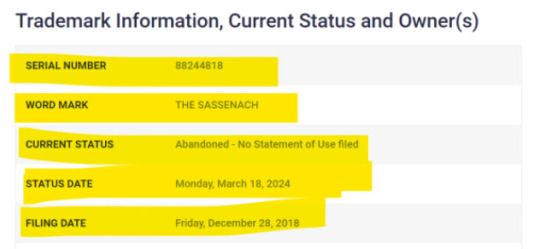
Separate categories, as per US regulations, need separate filings, of course. And beer is a brilliant, simple idea, with high quality local ingredients (it's really barley, water, hops and yeast) relatively easy to source. Well, spare perhaps for the hops, but that is not really a problem, anymore:

(Source: the James Hutton Institute's booklet Hops in Scotland, 2018 - well, then. The institute is based in Dundee, by the way, so I think they know exactly what they are talking about, especially after a four year long feasibility study with encouraging results: https://www.hutton.ac.uk/news/scottish-hops-viable-commercial-crop-hutton-research-finds)
As I always make a point of reminding anyone, this page does not deal in fantasy and empty, meaningless scouring of social media accounts. And cackle to your heart's content, Mordor, but S seems to have a genuine, informed interest in the industry, as shown above.
This is a different business plan and a different marketing model, based on affordable production costs and yield/volume (as compared to successive, 'limited batches' of tequila or whisky, where the accent is placed on the excellence of the product and know-how, as reflected in the final price tag). You can bottle that beer or you can sell it on tap, partnering with local bars and pubs first, then progressively extending that network. And I bet the farm it is going to be a premium, artisanal beer first, with options open for a more democratic product, once brand awareness is properly built: beer is versatile, like that.
Whisky and gin were expensive, carefully curated pet projects. Beer is a fun, easy and lucrative one, with a wider clientele and fast growing potential. And this is how that unknown, struggling Scottish actor who once was the face of Tennent's has a fair opportunity to strike it big. To be followed, which I might do. And this is also how his products could cover the entire price range, from luxury to affordable.
It is also always disheartening to see how all those bitter women congregating on certain Tumblr pages feel the need to dismiss anything he does. As I always said and I always will, many of them have no idea about the very basics of business and trade, no exposure to that world and, to be honest, no particular intellectual acuity. Plus I bet the farm many of them lie about their own circumstances: it's easy to pretend, on the Internet and always sexier (and lame, of course) to introduce yourself as a corporate whatever than a secretary. But I wonder how would they feel, in the unlikely situation they would be running their own lemonade stand, if passers by started cackling and bitching about their trade, out of the blue.
So, all in all, we seem to be dealing with some careful preparation, portfolio diversification and yes, taking much needed strides away from McGrandma. To be continued, of course...
PS: FMN Gin, still crickets? Ahhh...

77 notes
·
View notes
Text
ARTICLE: The Florida Man of Formula 1 (2023)
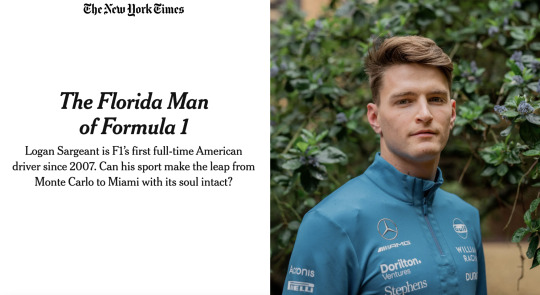
Source: Michael M. Grynbaum, The New York Times Series: F1, 2023
Logan Sargeant, the only American driver in Formula 1, is zipping around the narrow streets of Baku, Azerbaijan, at roughly 200 miles an hour. His head bounces inside the cockpit as a wheel shudders over a rumble strip. It’s hard to hear over the banshee shriek of his V6 engine, carrying three times the horsepower of a run-of-the-mill Porsche Carrera.
Then the noise stops, and Baku vanishes. We’re inside a low-slung brick building nestled in the Oxfordshire countryside. The track, projected onto a CinemaScope-sized wraparound screen, was a mirage, part of a sophisticated training simulator. (F1 rules prohibit driving the real cars between races.) Mr. Sargeant climbs out of a replica driver’s seat wearing athletic pants. He won’t need a fireproof suit until later.
In three weeks’ time, Mr. Sargeant will do this for real: wind whipping his visor, G-forces of up to six times his body weight pressing on his neck, the ever-present threat of a catastrophic crash as he is watched by roughly 70 million people around the world. For now, it’s time for lunch. “Is chili bad for you?” he asks, digging into a bowl at his team’s commissary. “I don’t think it’s that bad.”

Williams Racing, in Grove, England. It was founded in Oxfordshire in the 1970s, but it’s now an American subsidiary: a Manhattan private equity firm, Dorilton Capital, bought the company in 2020 for an estimated $200 million.

F1 teams employ hundreds of employees and spend hundreds of millions of dollars developing the world’s most sophisticated racecars.
Reaching Formula 1, the highest level of international motor sport, is a big step for Mr. Sargeant, 22, a South Florida native who began racing rudimentary cars known as karts at 6 years old and this year joined the Williams Racing team as the first full-time American F1 driver since 2007.
For Formula 1 itself, finding a hometown hero for American fans is a giant leap.
Although it is enormously popular in Europe, F1 struggled for decades to break into the United States. That began to change in 2016, when the sport was purchased for $4.4 billion by the Colorado-based Liberty Media, owned by the cable magnate John Malone. Liberty ramped up its social media — F1 had barely kept a YouTube page — and backed a popular Netflix documentary series, “Drive to Survive.” Once geared toward aging white men, F1 now has a younger and more diverse fan base. American TV viewership is up 220 percent from 2018, and the sport made $2.6 billion in revenue last year.
Still, a subset of F1 devotees complain about what they see as an overemphasis on entertainment and ginned-up drama. Under Liberty, they argue, pure racing is taking a back seat to cheap tricks to reel in casual viewers. And they often use a dirty word for it: Americanization. “It is becoming more and more like Formula Hollywood,” Bernie Ecclestone, the 92-year-old Briton who built F1 into a global business, griped last year. “F1 is being made more and more for the American market.”
The backlash reached a crescendo at last week’s Miami Grand Prix, which was added in 2022 as a showpiece for American fans. In a prizefight-style pre-race ceremony, the rapper LL Cool J introduced the 20 drivers one by one amid swirling smoke and a squad of cheerleaders. Nearby, Will.i.am conducted a live orchestra playing the rap song he recently recorded with Lil Wayne as part of a “global music collaboration” with Formula 1. (The lyrics rhyme “Max Verstappen,” the name of the sport’s top driver, with “your champion.”)
“Pandering to the American audience is killing @F1,” wrote one fan on Twitter, echoing criticism that bubbled up across numerous F1 websites. Even the racers complained: “None of the drivers like it,” groused Lando Norris, a Briton who drives for McLaren. Undeterred, Liberty announced that the bombastic pre-race sequence would be featured at several more grands prix this year.

In the United States, F1 has long been associated with a certain European mystique, most famously, the louche glamour of the Monaco Grand Prix.
In the United States, F1 has long been associated with a certain European mystique. Its drivers race across the Ardennes forest (Circuit de Spa-Francorchamps in Belgium), the plains of Lombardy (Italy’s Autodromo Nazionale di Monza) and, most famously, the louche glamour of the Monaco Grand Prix. The sport’s stateside image could be summed up by the 2006 comedy, “Talladega Nights: The Ballad of Ricky Bobby,” which featured Sacha Baron Cohen as a pretentious French F1 driver named Jean Girard, a snooty Eurotrash foil to Will Ferrell’s macho NASCAR cowboy.
In 2023, F1 can feel a bit more Ricky Bobby than Jean Girard. In Miami, drivers circled a track built in the parking lot of the Dolphins football stadium, past an artificial Monaco-style “harbor”: blue-painted asphalt topped with ersatz yachts. A new Las Vegas race in November will have cars zooming down the Strip past Caesars Palace. Meanwhile, traditional races in France and Germany are gone.

Katy Fairman, a journalist based in Brighton, England, who runs the F1 podcast “Small Torque,” said she was surprised by the spectacle when she attended a race in Austin, Texas. “There were girls with pompoms,” she said. “I remember watching it and thinking, Oh my gosh, this is so different from anything I’d seen F1 do in a long time.”
Ms. Fairman conceded that some Europeans find the American hullabaloo “tacky.” But she added: “When it’s something to do with America, I think Europeans are quite judgmental. I think it’s just a bit of lighthearted fun. You guys like to have a party.”
The arrival of Mr. Sargeant, who grew up about an hour’s drive from the Miami racetrack, has spurred new interest, including a profile and photo shoot in GQ, and he’s happy to play the part. “What’s up America, let’s bring that energy!” he shouted to the cameras after LL Cool J introduced him as “the local boy done good.”
But as with F1, there are growing pains. In Miami, Mr. Sargeant finished last, his race ruined on the first lap when he damaged a front wing. After the checkered flag, he apologized to his team, his voice barely a whisper: “I’m so sorry. I can’t believe it.”
Weeks earlier, in an interview in England, Mr. Sargeant had demurred about the pressure of wearing the stars and stripes. “I try not to get too caught up in the talk of the role of ‘first American,’” he said. “It’s still very early for me, and I have a lot to learn still.”
If Mr. Sargeant doesn’t perform, there are dozens of drivers eager to take his spot. “At the moment,” he said, “I just have to worry about staying here.”

For a globe-trotting athlete, Mr. Sargeant can be soft-spoken and endearingly self-conscious.
‘I just want to get back in the gym.’
Before his tough Miami weekend, Mr. Sargeant was asked how he would celebrate a top 10 finish. “Honestly, it might sound lame, but probably just go back to my house and get in my bed for another night before I go back to London,” he replied. “That’s all I want to do.”
For a wealthy, handsome, globe-trotting athlete, Mr. Sargeant can be soft-spoken and endearingly self-conscious. It’s not unusual for someone who, like a tennis prodigy or Olympian gymnast, has devoted their life since childhood to a sole pursuit.
Mr. Sargeant was 6 when he and his brother Dalton got a kart from their parents for Christmas. “No one in the family was really even that much into racing,” Logan said. “We just picked it up as a hobby, something to do on the weekend.” He began winning junior races around the country — too easily. To reach the next level and pursue Formula 1, he’d have to leave behind his friends and beloved fishing excursions for life on a different continent: “We just needed a higher level of competition, and at the end of the day, that was in Europe.”
Mr. Sargeant left Florida before his 13th birthday, bouncing between Italy, Switzerland and Britain as he raced on the European junior circuit; in 2015, he became the first American to win the Karting World Championship since 1978. “As a kid, it was tough,” he recalled. “Coming from Florida, being outdoors all the time on the water, great weather �� it was literally vice versa.” He eventually settled in London, where he spends most days working out with a trainer. “I get away from a race weekend, and I just want to get back in the gym,” he said. “I hate that feeling of leaving slack on the table.”
It is incredibly difficult to nab a seat in Formula 1. Today’s drivers are physical dynamos trained to optimize their reflexes and performance levels down to how well they can withstand jet lag — critical in a sport that this year will include 23 grands prix spread over five continents. F1 teams employ hundreds of employees and spend hundreds of millions of dollars developing the world’s most sophisticated racecars. But it’s ultimately up to the driver to execute.
It also helps to have money. Lewis Hamilton, the seven-time world champion and F1’s only Black driver, is an exception, having grown up on a London council estate. Many F1 competitors are the sons of multimillionaires (and some billionaires) who can bankroll pricey travel and high-tech cars.
Mr. Sargeant falls into the scion category. He hails from a wealthy Florida asphalt shipping family. His uncle, Harry Sargeant III, is a former fighter pilot and onetime finance chair of Florida’s Republican Party who has been sued by the brother-in-law of King Abdullah II of Jordan and whose name turned up, tangentially, in the 2020 impeachment of former President Donald J. Trump. (Harry was not accused of any wrongdoing.)
Logan’s father, Daniel Sargeant, worked alongside Harry until the brothers had a falling out. In a 2013 lawsuit, Harry accused Daniel of misdirecting $6.5 million in corporate funds “for the purpose of advancing the international cart racing activities” of his sons, Logan and Dalton; that litigation was eventually settled.
In 2019, Daniel Sargeant pleaded guilty in federal court in New York to foreign bribery and money laundering charges related to his business dealings abroad. He is free on a $5 million bond and is awaiting sentencing. A Williams spokesman said that Logan Sargeant was not “in a position to comment” on any of the legal matters involving his family.
In F1, none of this particularly stands out. The mother of Mr. Sargeant’s Williams teammate, Alexander Albon, was jailed in Britain for swindling millions of pounds in fraudulent sales of high-end cars. A Russian racer, Nikita Mazepin, was booted from the sport after his oligarch father, a close ally of President Vladimir V. Putin, was sanctioned following the 2022 invasion of Ukraine.
James Vowles, the Williams team principal, said in an interview that he hired Mr. Sargeant for his speed, not his U.S. passport. “I’m incredibly pleased that the sport is growing in America, but I think it would be anything but disingenuous to say that Logan’s here for any other reason than I think he’s got this pure talent,” he said.
In his F1 debut in Bahrain in March, Mr. Sargeant finished 12th, outpacing this year’s two other rookies. “He has this insatiable desire to be better, to want more,” Mr. Vowles said. “He’s a perfectionist, and I like that in him.”
Tooting around in a Vauxhall Astra
Britain, where Formula 1 originated in 1950, remains the sport’s spiritual home, where most of its 10 teams are based. Williams was founded in Oxfordshire in the 1970s, but it’s now an American subsidiary: a Manhattan private equity firm, Dorilton Capital, bought the company in 2020 for an estimated $200 million.
It was an important cash infusion for a team that had struggled to keep up with rivals. Manufacturers like Mercedes-Benz pour enormous resources into their F1 teams, which double as an elaborate global marketing campaign and an in-house innovation farm; tech developed for F1, like engines that recycle braking energy as an accelerant, can trickle into consumer vehicles.

Formula 1 car simulators at the Williams Racing factory.

Formula 1 drivers practice on sophisticated training simulators.
The Williams campus is a humdrum brick pile that could be mistaken for an office park — a far cry from McLaren’s space-age complex an hour’s drive away. Many F1 teams provide their drivers with a high-end sports car for personal use; Mr. Sargeant commutes in a Vauxhall Astra, a compact.
Even the team’s sponsors are relatively down-market; whereas the official watch of Ferrari is Richard Mille (starting price: $60,000), Williams has a deal with Bremont, whose timepieces retail for significantly less. (On a recent visit, a Williams press aide was quick to extract a spare Bremont watch from his pocket and ensure Mr. Sargeant was wearing it whenever a photographer hovered.)
Given the huge costs, corporate partnerships are crucial to F1, part of the reason the American market, with its abundance of affluent consumers and wealthy brands, has proved so tempting. Gerald Donaldson, a journalist who has covered F1 for 45 years, recalled how cars were gradually taken over by corporate logos starting in the late 1960s.
“Marlboro paid all the Ferrari bills, including the drivers, for many years,” he said in an interview. “There are eager companies who want the publicity.” Mr. Sargeant’s car features ads for Michelob Ultra beer and an American financial firm, Stephens. In Miami last weekend, beachgoers spotted an airborne banner reading “Go Logan!” alongside the image of a Duracell battery.
Last year, the Miami race was viewed on ABC by 2.6 million people, the biggest American audience for a live F1 telecast. Ratings for this year’s race fell about 25 percent, perhaps a result of a duller-than-usual season dominated by one team, Red Bull.
Still, viewing data show that F1 is expanding beyond affluent cities associated with elite sports: In 2022, its top five American TV markets included Asheville, N.C., and Tulsa, Okla. ESPN is clearly betting on more growth. When the sports network renewed its broadcast rights last year, it agreed to pay $90 million annually — up from the $5 million-a-year deal it signed in 2019.
Liam Parker, a former adviser to Boris Johnson who now leads communications at F1, said the sport was intent on rectifying past mistakes. “We were too arrogant,” he said. “We couldn’t understand why the American fan base wasn’t falling in love with us.” But he also pushed back on the complaints that Liberty’s efforts to raise the entertainment factor had stripped F1 of something essential.
“This whole argument of ‘Americanization,’ it’s a very crude way to describe things,” he said. “We shouldn’t ignore things that can improve things for new and core fans. It’s about giving people more choices in the modern era. It’s modernization of access to everyone.”
Mr. Hamilton, arguably the biggest celebrity of the current F1 lineup, has offered his own endorsement of Liberty’s approach. “I mean jeez, I grew up listening to LL Cool J,” he told reporters in Miami. “I thought it was cool, wasn’t an issue to me.”
For all the debates over elitism, good taste and corporate rap collaborations, the core appeal of F1, when you get right down to it, may be something simpler — something Mr. Sargeant got at when asked in the interview if he had loved cars as a kid.
“I absolutely love driving, as you can imagine,” he said. “But to be honest, I’m not one of those people who studies cars and, you know, likes to know every detail of every single car. It doesn’t really interest me.”
“The part that interests me,” he concluded, “is driving them as fast as I can go.”
Eliza Shapiro contributed reporting from Miami. Kitty Bennett contributed research. Michael M. Grynbaum is a media correspondent covering the intersection of business, culture and politics. A version of this article appears in print on May 14, 2023, Section BU, Page 1 of the New York edition with the headline: The Florida Man Of Formula 1.
#logan sargeant#year:2023#source:newspaper#one of the best logan articles imo#feel free to message me if you want me to gift you a copy of this article from the NYT with my subscription
77 notes
·
View notes
Text
The term “climate haven” never made much sense. After Hurricane Helene dumped 2 feet of rain on western North Carolina, many major media outlets marveled at how Asheville, which had been celebrated as a climate haven, had been devastated by a climate-related disaster.
Some in the media later reported accurately that climate havens don’t actually exist. But that still raises the question: Where did this climate haven concept even come from?
Well before humans began putting billions of tons of greenhouse gases into the atmosphere, entire populations would migrate toward better conditions in search of a place with milder weather or more fertile soil or the absence of drought.
Because of its speed and scale, however, human-caused climate change is especially extreme, and everywhere will be impacted by some degree of risk. There is no completely safe haven.
Which is part of how we ended up talking about the idea of climate havens. It’s wishful thinking. At least that’s what several experts told me after Helene laid a path of destruction across the Southeast and as Hurricane Milton barreled toward Florida. As the impacts of climate change became more real and apparent, the media as well as local leaders started looking for a better story to tell.
“People are desperate for optimism,” said Jesse Keenan, director of the Center on Climate Change and Urbanism at Tulane University, who described the concept of climate havens as a fiction. “It gives people hope.”
Keenan actually blames himself for helping to popularize the term. For a concept that feels so widespread now, it’s surprisingly hard to find much mention of climate havens in the media before 2018. That was when The Guardian quoted Keenan in a piece about where you should move to save yourself from climate change that used the phrase “safe havens.” Buffalo, New York, and Duluth, Minnesota, were Keenan’s suggestions.
The concept gained more traction a few months later, when Mayor Byron W. Brown referred to Buffalo as a “climate refuge” in his 2019 state of the city address, followed by outlets like Bloomberg and Quartz referring to Buffalo as a climate haven. The New York Times did a whole spread on “climate-proof Duluth,” a slogan Keenan wrote as part of an economic development package commissioned by the city. He told me it was just a joke that got pulled out of context.
It’s hard to know how responsible one professor with a knack for marketing was for the mainstreaming of the climate haven concept. But it’s easy to see why local governments would latch onto it.
The Census Bureau estimates that as climate change warms the planet over the next several decades, 100 million will migrate into and around the US. Increased flood risk may have already pushed several million people out of coastal and low-lying areas across the US, as wildfires start to raise questions about migration in the West.
Inland cities, namely those along the Rust Belt that have been losing population for years, see an opportunity to pull those people in.
“The idea of a climate refuge itself is kind of an escapist fantasy,” said Billy Fleming, director of the McHarg Center at the University of Pennsylvania. “To the extent that a climate refuge even exists, it’s not a particularly physical or geophysical phenomenon. It’s social and economic.”
Fleming added that, for these would-be climate havens, attracting new residents is a means to pull in more tax revenue and create wealth for the community. “It’s about keeping the real estate machine churning,” he added, “which is the thing that pays for everything else in the city.”
The real estate industry has taken notice. Quite coincidentally, as Hurricane Helene was bearing down on the Southeast last week, Zillow announced a new feature that displays climate risk scores on listing pages alongside interactive maps and insurance requirements. Now, you can look up an address and see, on a scale of 1 to 10, the risk of flooding, extreme temperatures, and wildfires for that property, based on data provided by the climate risk modeling firm First Street. Redfin, a Zillow competitor, launched its own climate risk index using First Street data earlier this year.
The new climate risk scores on Zillow and Redfin can’t tell you with any certainty whether you’ll be affected by a natural disaster if you move into any given house. But this is a tool that can help guide decisions about how you might want to insure your property and think about its long-term value.
It’s almost fitting that Zillow and Redfin, platforms designed to help people find the perfect home, are doing the work to show that climate risk is not binary. There are no homes completely free of risk for the same reasons that there’s no such thing as a perfect climate haven.
Climate risk is a complicated equation that complicates the already difficult and complex calculus of buying a home. Better access to data about risk can help, and a bit more transparency about the insurance aspect of homeownership is especially useful, as the industry struggles to adapt to our warming world and the disasters that come with it.
“As we start to see insurance costs increase, all that starts to impact that affordability question,” Skylar Olsen, Zillow’s chief economist, told me. “It’ll help the housing market move towards a much healthier place, where buyers and sellers understand these risks and then have options to meet them.”
That said, knowledge of risk isn’t keeping people from moving to disaster-prone parts of the country right now. People move to new parts of the country for countless different reasons, including the area’s natural beauty, job prospects, and affordable housing. Those are a few of the reasons why high-risk counties across the country are growing faster than low-risk counties, even in the face of future climate catastrophes, which are both unpredictable and inevitable. It’s almost unfathomable to know how to prepare ourselves properly for the worst-case scenario.
“The scale of these events that we’re seeing are so beyond what humans have ever seen,” said Vivek Shandas, an urban planning professor at Portland State University. “No matter what we think might be a manageable level of preparedness and infrastructure, we’re still going to see cracks, and we’re still going to see breakages.”
That doesn’t mean we shouldn’t build sea walls or find new ways to fight wildfires. In a sense, we have the opportunity to create our own climate havens by making cities more resilient to the risks they face. We can be optimistic about that future.
19 notes
·
View notes
Text
I’m not interested in defending celebrities, to be so for real, but I am interested in a crumb of whatever drugs this blogger is on. This kind of standom delusion must feel amazing. 💊💊
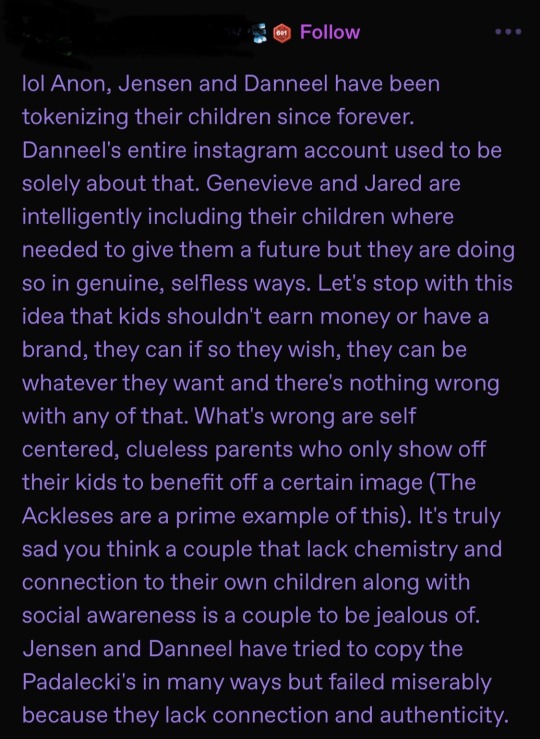
It’s so funny to me when stans go after each other and fail to realize that they are all engaging in the same kind of “Nuh-uh! That other side sucks the hardest because of all this very biased data I’ve compiled” type of arguing. I’m also not interested in warring with any stan blogs, but this was just so egregious and needed to be debunked. So let’s unpack:
Right off the bat, this blog has used the word tokenize incorrectly. This means to use someone as a symbol of inclusion or compliance with regulations, or to avoid the appearance of discrimination or prejudice.
I think they are intending to refer to the kids being a commodity to exploit in the overall branding of the family; that they are being objectified. And one only has to skim the Instagram feeds of Danneel and Gen to see which family is more heavy-handed. “Danneel’s entire Instagram use to be solely about that.”Based on what, exactly? Danneel’s very first post is of Jensen and JJ, yes, and her identity as wife and mother is (gasp) very much on display ever since. But…that’s to be expected, right?! After all, sharing those parts of their family life on socials is exactly the whole point and why anyone initially followed. It is that behind the scenes peek into the family lives of J2 that drew people in. It’s not as if either of these women has much of a fan base on their own and neither of them were acting at the time their IG accounts launched.
A quick side-by-side of the 2 accounts at about the same point in time (2017/2018) shows little differences in themes of content:
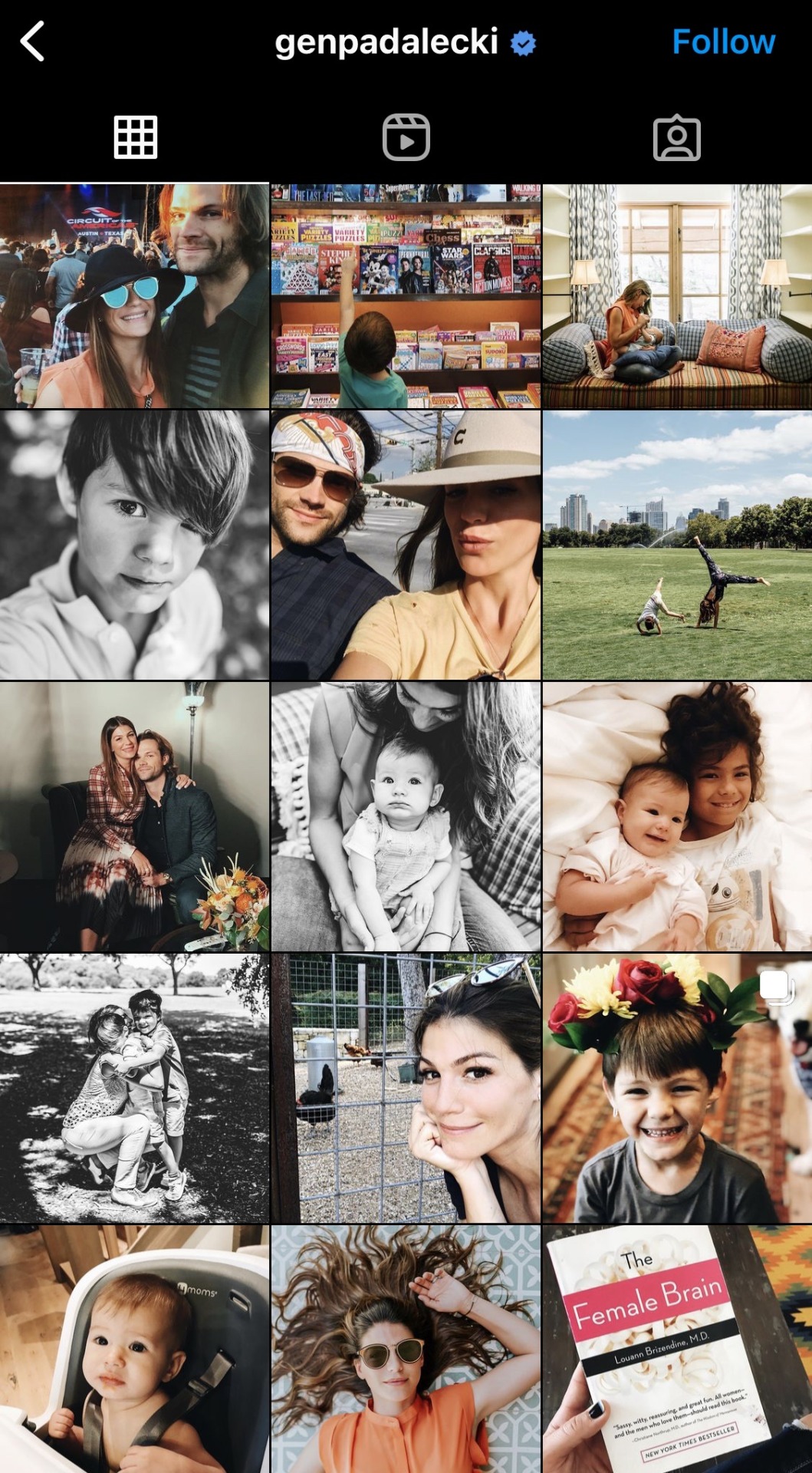
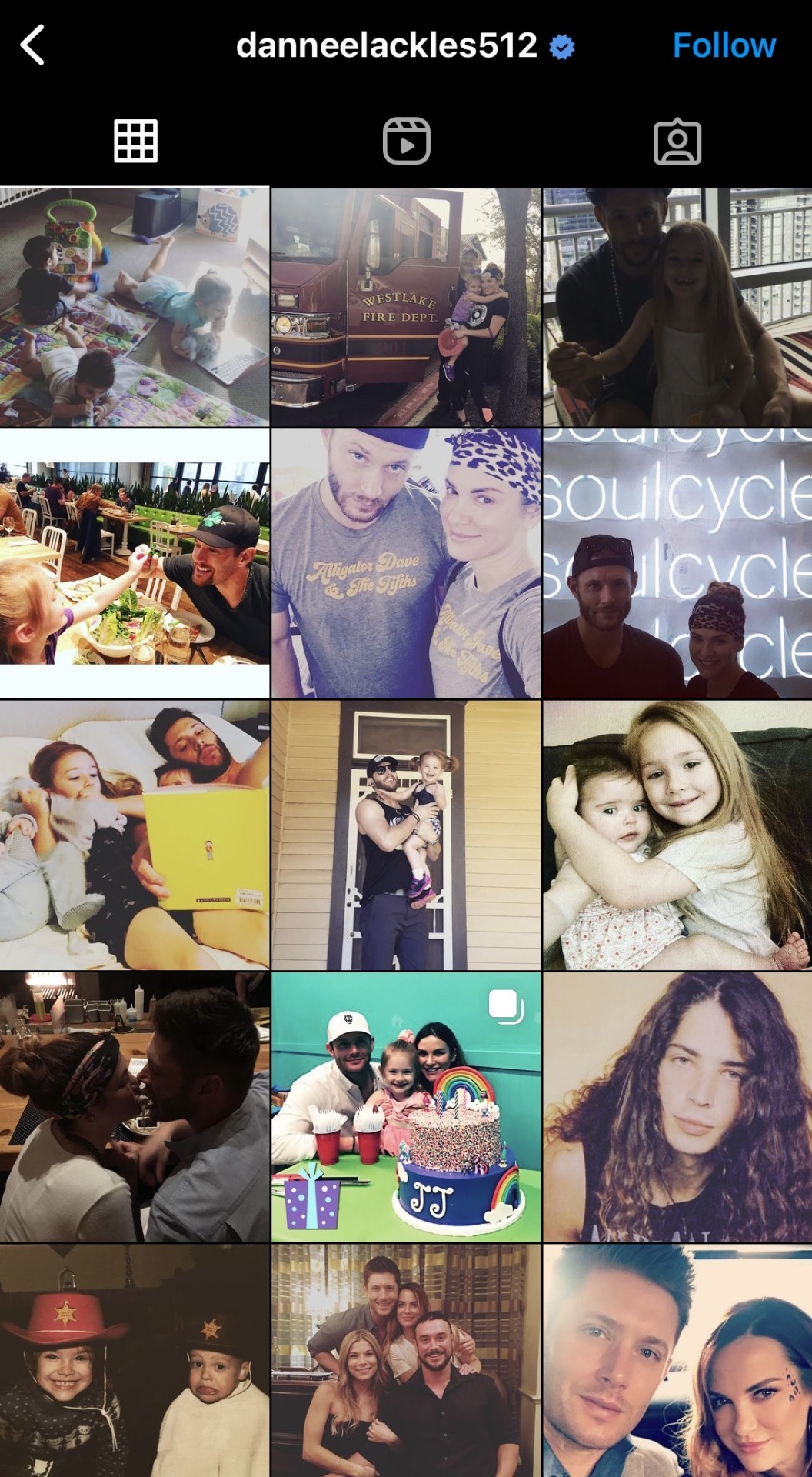
This blog further claims that “Genevieve and Jared are intelligently including their children where needed” and doing so in “genuine, selfless ways.” *snorts* At the time of this writing, Danneel has 458 posts and Gen has 1,833. Now, I didn’t review each post but the few tags I saw included in family photos were Disneyland and Warner Bros when they visited in recent years. I did not see multiple paid partnership ads featuring the Ackles children. I’m open to anyone proving me wrong, because by sheer volume my argument will still stand. In a random sampling of 2021, we have a string of posts of the Pada-kids that double as ads to varying degrees. Here are just a few examples:



Now you might say, “ok but these are products for children and families…that still seems pretty thoughtful.” Except that one need only scroll a little farther to see the kids included in brand deals for adult supplements, exercise gear, cleaning products, and even shampoo.
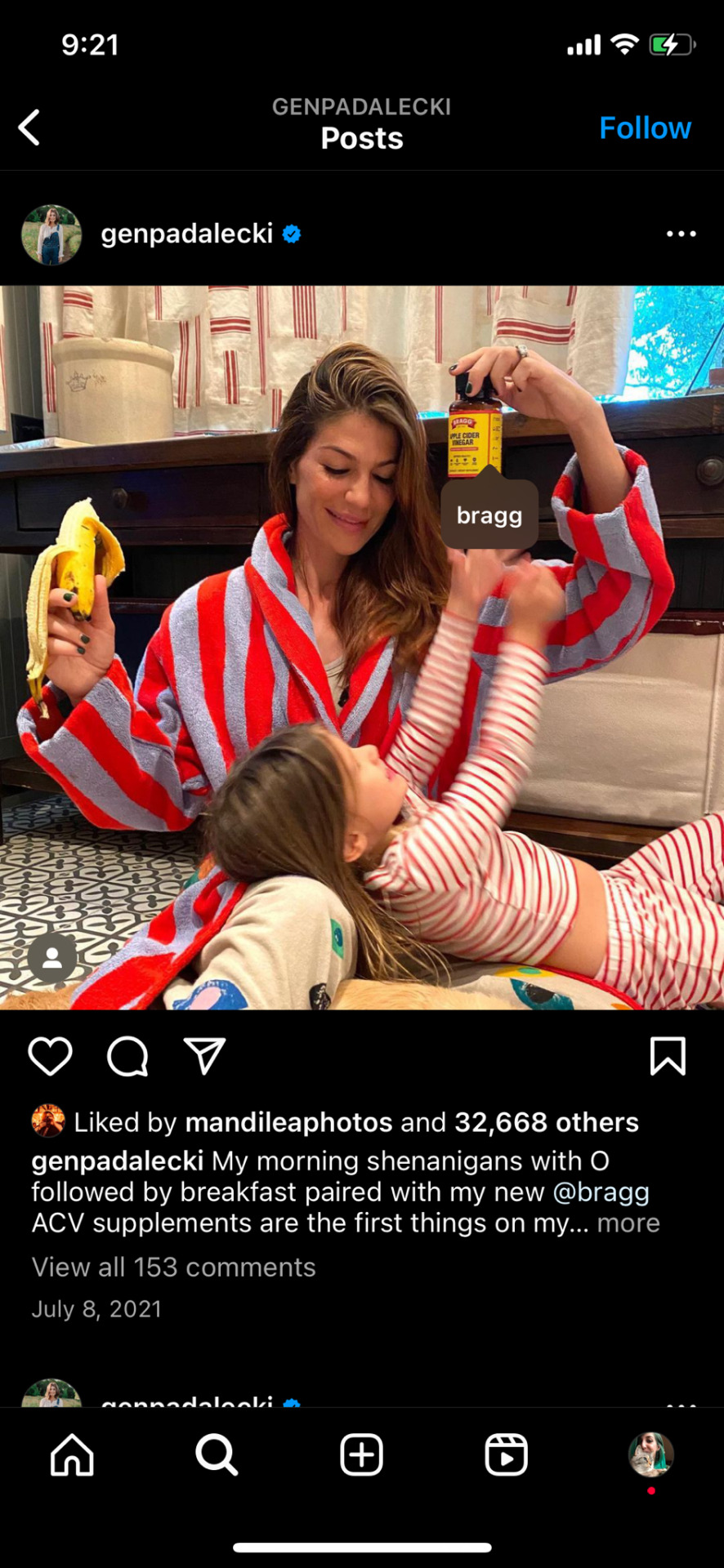
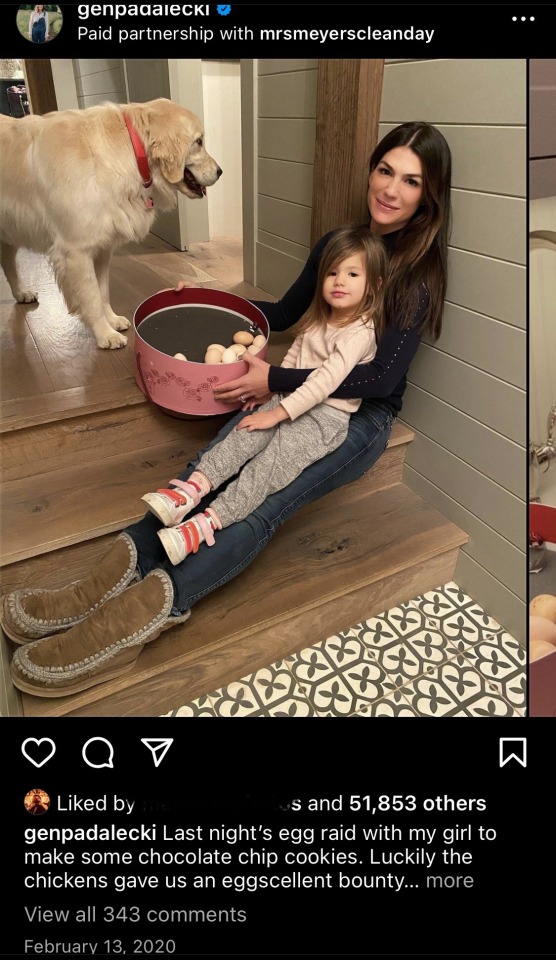

All of these products still fit in the “items that help me be a great mom” theme of the Now & Gen era, but this is still blatantly using images of the kids for profit in ways that the Ackles just have not done. What is shown here is just the tip of the iceberg and does not include the other attempts at branding on the failed Now & Gen blog or the YouTube vlog. So I’m not sure how the Pads have only used the kids “when needed” when this family was never going to go hungry without these endorsement deals.
Comparing the volume of likes on Gen’s IG posts that contain the children vs those that do not makes it seem likely that someone has been paying attention to the trends and has concluded that utilizing the children in ads has more earning potential. This is the current climate of social media marketing. These outcomes are in fact considered.
The idea that kids should be allowed to “earn money or have a brand” if they want is actually incredibly irresponsible. Protecting the safety of children that are a part of family content creation was a popular topic over the last year. There have been several examples of families who lost the plot in their efforts to market their children in order to achieve financial gain. What an asinine claim to make for children in general when Google is right there. And I love a link, so here’s a few: X, X, and X. It’s too early to definitively summarize the harm that the Pads might be causing their kids with all the exposure. Even when parents are not intentionally exploiting, their children are too young to consent to this type of “work.” Their brains are literally not developed enough to consider the long term pros and cons. All of this sets them up for potential harm, the risk of which makes none of this a need.
“What’s wrong are self-centered, clueless parents who only show off their kids to benefit off of a certain image.” (Pretending I can’t see the self-centered bit because woooo boy…Gen…😬) But aren’t both families posting photos of their kids to “benefit” off of their image of “family?” It’s baked into the Spn and even Walker marketing. The fandoms have been referred to as a family almost since their inception, so it only makes sense that fans were interested in the leads and their own growing families. Again, both families have benefitted but the Pads have benefitted all the way to the bank. And some Padalecki stans are quick to point this out as a win. If the above blog wants to congratulate Gen on her shrewd sense of business and use of capitalism, then that is a whole other thing and they should just come out and say that without making anyone out to be a saint.
One should take note that nowhere in here have I said that Danneel or Jensen are better people than anyone. I didn’t praise them for anything or proclaim their intentions are always pure of heart. How could anyone know that, except by virtue of the faith that comes along with extreme fandom? And that faith isn’t the same as screenshots, numbers, and patterns.
As always: Pedestals aren’t for people. Hold everyone accountable, even your faves. They will survive.✌🏼
32 notes
·
View notes